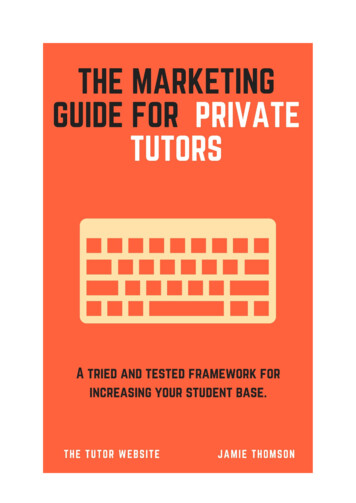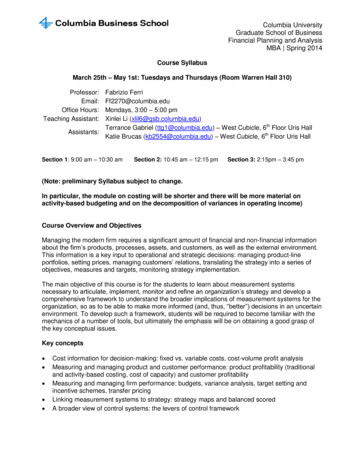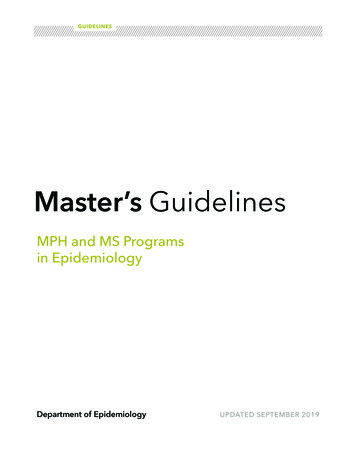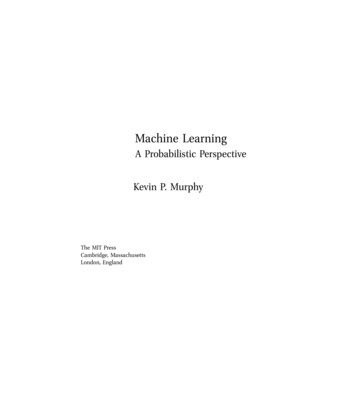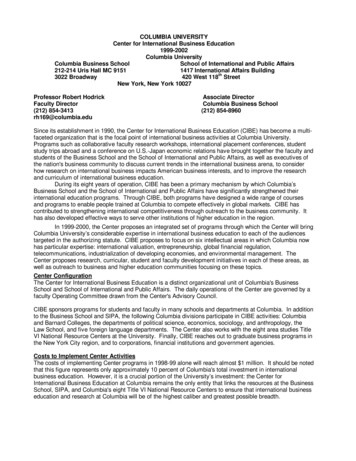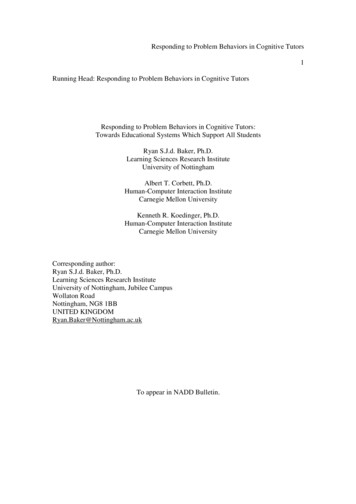
Transcription
Responding to Problem Behaviors in Cognitive Tutors1Running Head: Responding to Problem Behaviors in Cognitive TutorsResponding to Problem Behaviors in Cognitive Tutors:Towards Educational Systems Which Support All StudentsRyan S.J.d. Baker, Ph.D.Learning Sciences Research InstituteUniversity of NottinghamAlbert T. Corbett, Ph.D.Human-Computer Interaction InstituteCarnegie Mellon UniversityKenneth R. Koedinger, Ph.D.Human-Computer Interaction InstituteCarnegie Mellon UniversityCorresponding author:Ryan S.J.d. Baker, Ph.D.Learning Sciences Research InstituteUniversity of Nottingham, Jubilee CampusWollaton RoadNottingham, NG8 1BBUNITED KINGDOMRyan.Baker@Nottingham.ac.ukTo appear in NADD Bulletin.
Responding to Problem Behaviors in Cognitive Tutors2Introduction.In the last twenty years, interactive learning environments and computerizededucational supports have become a ubiquitous part of students’ classroom experiences,at all levels of the educational system. As interactive learning environments play anincreasingly large role in the educational system, it becomes increasingly important thatthey be made appropriate for the full spectrum of students, including students withlearning and developmental disabilities, behavioral problems, and language deficits. Forthis reason, in recent years, there has been increasing research into how interactivelearning environments can accommodate students with disabilities (Stiles, 2001; Cole etal., 2003; Moore & Taylor, 2003). The presence of a developmental disability along witha mental illness heightens the need for effective educational interventions (Prout, 2005).Prout eloquently framed the need for increased attention to diagnosis and intervention forschool-aged youth with dual diagnoses (2005). The scarce attention to this population hastended to focus on treatment rather than educational intervention.In this paper, we will discuss work towards ensuring that one type of educationalsystem, Cognitive Tutors (Koedinger, Anderson, Hadley, & Mark, 1997), help allstudents achieve. Cognitive Tutors are a type of interactive learning environment whichuse cognitive modeling and artificial intelligence in order to adapt to individualdifferences in student knowledge and learning. Cognitive Tutors are designed to beintegrated into full-year curricula; students use the Cognitive Tutor software two days aweek, and engage in group work and classroom lecture on other class days. Within theCognitive Tutor environment, each student individually completes mathematics
Responding to Problem Behaviors in Cognitive Tutors3problems. The Cognitive Tutor environment breaks down each mathematics problem intothe steps of the process used to solve the problem, making the student’s thinking visible.The Cognitive Tutor environment also supports the student in representing a problem inmultiple ways, including equations, tables, and graphs (Koedinger et al., 1997).As the student works through a problem, their work is analyzed by a model ofstudent cognition in the problem domain (cf. Anderson, Corbett, Koedinger, & Pelletier,1995). Incorrect answers turn red; if the student’s answer is not just incorrect butindicative of a larger misconception, the student is given a text explanation (see Figure1). If a student is struggling, he or she can also request a hint. When the student requestsa hint, the system first gives a conceptual hint. The student can request further hints,which become more and more specific until the student is given the answer (see Figure2).[Place Figure 1 around here][Place Figure 2 around here]As the student works through the problems in a specific curricular area, thesystem uses Bayesian knowledge-tracing (Corbett & Anderson, 1995) to determine whichskills that student is having difficulty with – calculating the probability that the studentknows each skill based on that student’s history of responses within the tutor. Using theseestimates of student knowledge, the tutor can give each student exercises which arerelevant to the skills which that student is having difficulty with. The tutor does not moveon to new material until the student has reached mastery (defined as a 95% probability of
Responding to Problem Behaviors in Cognitive Tutors4knowing each skill) on all of the skills relevant to the current curricular area. Hence, eachstudent works at a pace appropriate to his/her learning, and when the student reaches eachsection of the tutor curriculum, he or she is completely prepared with all of the prerequisite knowledge necessary to succeed on the new material.Cognitive Tutors have been highly successful at improving the learning outcomesof at-risk students. In a large-scale study in El Paso, TX, previously failing students whore-took Algebra using a Cognitive Tutor curriculum had significantly better performanceon state standardized exams than students who re-took Algebra using a traditionalcurriculum (Carnegie Learning, 2002). In another large-scale study in Kent, WA,previously failing students using a Cognitive Tutor Algebra curriculum had significantlyhigher learning gains on a standardized exam than students using a traditionalmathematics curriculum who had passed their previous mathematics course (Plano,2004). Because of their documented and replicated success at improving learningoutcomes, Cognitive Tutor mathematics curricula are currently in use in around 6% ofU.S. high schools.Though Cognitive Tutors were designed for mainstream mathematics classes,rather than special education classes, recent research has indicated that Cognitive Tutorsare also extremely effective for students with learning disabilities and English-languagedeficits. In a large-scale experimental study conducted throughout the Miami-DadeCounty school district, students with learning disabilities and language deficits performedsignificantly better on a year-end state standardized exam after completing an Algebra Icourse taught using Cognitive Tutors, instead of a course taught using a traditionalmathematics curriculum (Sarkis & The Reliability Group, 2004). In this study, the
Responding to Problem Behaviors in Cognitive Tutors5performance gap between students with learning disabilities and students in mainstreamclasses was reduced by 3/4 when students used Cognitive Tutors instead of a traditionalcurriculum. Similarly, in Kent, WA, students with English-language deficits performedalmost twice as well if they used a Cognitive Tutor curriculum rather than a traditionalcurriculum (Plano, 2004).These reports have not speculated on why Cognitive Tutors are more effective forstudents with learning disabilities and English-language deficits. Many of the samefeatures that make Cognitive Tutors beneficial for mainstream students may explain whyspecial-needs students also benefit from using Cognitive Tutors. For instance, thesoftware’s ability to select exercises tailored to each student’s current knowledge is likelyto benefit special-needs students in much the same fashion as it benefits mainstreamstudents. The individual pacing is likely to benefit students with learning disabilities, whomay need extra time to mastery the material. The use of multiple representations maybenefit students whose learning disabilities hinder their ability to learn verbally orvisually. The use of multiple graphical representations may also explain part of thesoftware’s success with students who have limited English or linguistic ability. Anexpansion of educational strategies for learners with the dual diagnoses of mental illnessand developmental disability may be of great benefit (cf. Prout, 2005).Gaming the SystemThough there is evidence that Cognitive Tutors are effective for students withlearning disabilities and English-language deficits, a recent study has suggested thatCognitive Tutors are less effective for students who engage in some problem behaviors.In particular, students who engage in a behavior termed “gaming the system” have
Responding to Problem Behaviors in Cognitive Tutors6significantly poorer learning than other students (Baker, Corbett, Koedinger, & Wagner,2004). Gaming the system is defined as attempting to complete problems by exploitingproperties of the system rather than by learning the material and trying to use thatknowledge to answer correctly. Gaming has been documented in a variety of types ofinteractive learning environments (Baker et al., 2004; Cheng & Vassileva, 2005;Magnussen & Misfeldt, 2004) and even in interactions between students and humanteachers (Arbreton, 1998). In the specific context of Cognitive Tutors, gaming the systemconsists of guessing systematically and requesting hints until the answer is given, withoutreading the earlier hints. While there are no data to document this phenomenon in thepopulation of students with dual diagnosis, it can be postulated to exist at levels similar tothose in the population of students with learning disabilities.Students who game Cognitive Tutors tend to start out with lower prior knowledgeof the material than the rest of the class, and tend to have lower scores on general tests ofacademic achievement. Though many students with low prior knowledge catch up to therest of the class, students who game fall further behind over the course of the tutor lesson.(Baker et al., 2004). Gaming is particularly detrimental for students who tend to game onthe specific problem steps that they do not know (Baker, Corbett, & Koedinger 2004).Hence, existing Cognitive Tutors appear to be effective for many students withlearning disabilities but not for students who engage in a specific problem behavior,gaming the system. In order to adapt appropriately to the full spectrum of students,Cognitive Tutors will need to adapt appropriately when a student games the system. Inthis paper, we detail a system that adapts when students game, and present a case studyshowing how this system’s adaptive behavior can improve gaming students’ learning.
Responding to Problem Behaviors in Cognitive Tutors7Responding Automatically to when Students Game the System.To address gaming, we developed a new component for Cognitive Tutoringsoftware – an animated agent named “Scooter the Tutor”. Scooter is designed to reducethe incentive to game, by giving gaming students extra exercises, while at the same timehelping students learn the material they were avoiding by gaming, by targeting thoseextra exercises to the exact steps a student gamed. Scooter was also designed to affectnon-gaming students as minimally as possible – if a student does not game, theirexperience using the tutor changes very little.[Place Figure 3 around here]Scooter the Tutor is a puppy character, using graphics from the Microsoft OfficeAssistant, modified to enable Scooter to display a wider range of emotions. Scooter usesan artificial intelligence-based detector to determine whether a student is gaming (onsteps the student does not already know), and what problem steps they are gaming on(Baker, Corbett, & Koedinger 2004). If a student is not gaming, Scooter looks happy andoccasionally gives the student positive messages. If there is moderate evidence ofgaming, Scooter looks upset, and gives the student a warning message. If there is strongevidence of gaming, Scooter responds in a more serious fashion, giving the student a setof supplementary exercises designed to give the student another chance to cover thematerial that the student may bypassed by gaming. These supplementary exercisesinclude items which require understanding one of the concepts required to answer thestep the student gamed past, and questions about what role the step the student gamed
Responding to Problem Behaviors in Cognitive Tutors8past plays in the overall process of solving the problem. Examples of Scooter’sexpressions and supplementary exercises are given in Figure 3.Case Studies.In this section we will investigate, in detail, how the tutoring system’s adaptationto gaming changes students’ experience and learning within the tutor. To this end, wepresent a pair of case studies, comparing the behavior, experiences, and learning of twostudents who each engaged in a considerable amount of gaming. One of these studentsused a tutoring system which adapted to gaming (i.e. with Scooter); the other studentused a tutoring system without such adaptation.Each student was drawn from a set of middle-school classrooms in the Pittsburghsuburbs which used Cognitive Tutors as their regular curriculum, year-round, and whichwere participating in an experimental study comparing a tutor with Scooter to a tutorwithout Scooter (cf. Baker et al., to appear). Within the case studies that we will present,each student worked with the same tutor lesson on creating and interpreting scatterplotsof data.These two students were selected because of their similarity on the pre-test for thescatterplot unit, and the similarity of their behavior within the tutor, allowing us toconcretely examine how Scooter affects students’ experiences and learning.Using a Tutor That Did Not Adapt to Gaming. “Pat” (not his/her real name;neither names nor gender were recorded) performed poorly on his unit pre-test. Inparticular, Pat’s answers indicated the presence of a pair of common misconceptions (cf.Baker, Corbett, & Koedinger, 2002), where students select variables which would bemore appropriate for a bar graph than a scatterplot (one nominal variable and one
Responding to Problem Behaviors in Cognitive Tutors9quantitative variable), and represent quantitative variables on the axis as if they werenominal variables.Pat was observed gaming 10% of the time while using the tutor (by a humanobserver using a published quantitative observational method [Baker et al., 2004]).According to the detector, Pat never gamed on the steps involving the skill ofrepresenting a quantitative variable on the axis. However, the detector indicated that Patgamed 19 times (4.75 times per problem completed) on the problem
student cognition in the problem domain (cf. Anderson, Corbett, Koedinger, & Pelletier, . In a large-scale experimental study conducted throughout the Miami-Dade County school district, students with learning disabilities and language deficits performed significantly better on a year-end state standardized exam after completing an Algebra I course taught using Cognitive Tutors, instead of a .
